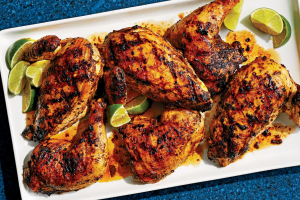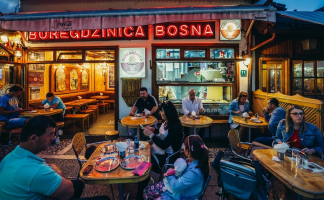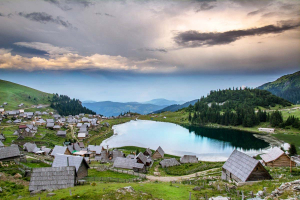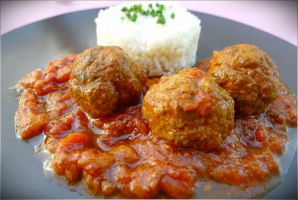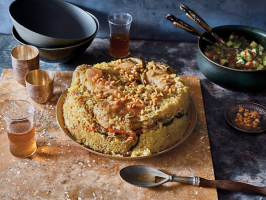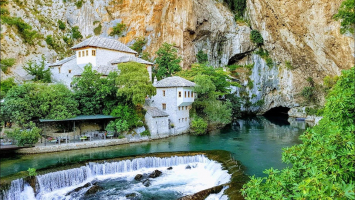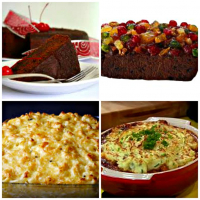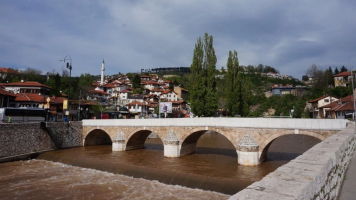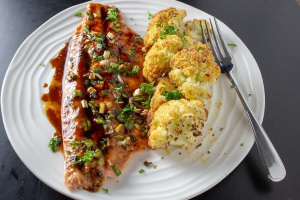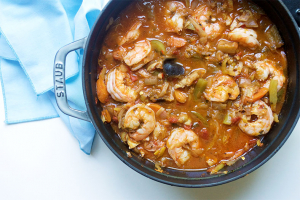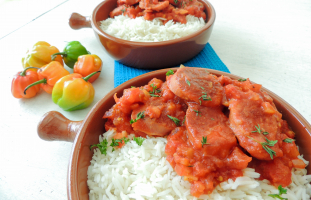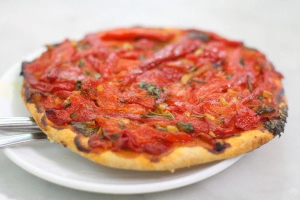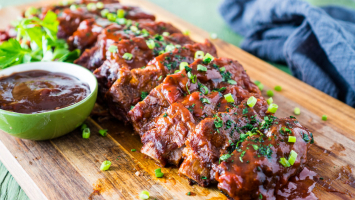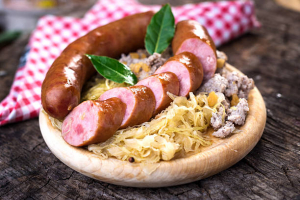Top 7 Best Foods In Bosnia and Herzegovina With Recipe
As a result of 400 years of Ottoman dominance, traditional Bosnian cuisine is comparable to Turkish and Mediterranean cuisine. Organic meat, usually lamb or ... read more...beef to suit Halal regulations, is slow-cooked in its juices with a seasoning of spices in typical recipes. Meals are often light and include a large amount of vegetables. Here are some delectable foods to sample during your next visit.
-
Cevapi are small, oblong-shaped lamb and beef kebabs served with raw onions in somun (Bosnian pita bread). This is served for lunch, dinner, or as a snack by the locals. The meat is grilled, and five to ten individual kebabs are served on a dish with a sour cream sauce. Each restaurant prepares and seasonings the cevapi differently, resulting in slightly different cevapi. Regional variations using mutton or lamb can also be found.
Ingredient
- 1 lb ground beef, 85% lean, ½ lb ground pork, 3 garlic cloves, minced, 1 ¼ tsp salt, 1 tsp ground black pepper, 1 tsp paprika, ¾ tsp baking soda
Instructions
- In a large bowl mix together all ingredients.
- Using slightly over 1 Tbsp of meat mixture per sausage, shape the mixture into sausages the size and shape of a fat finger (roughly 3 inches long and ¾ of an inch in diameter).
- Place all the formed sausages in a single layer on a platter. Cover the platter and refrigerate for at least 1 hour (up to overnight).*
- When you are ready to cook your sausages, preheat your grill to medium heat, 350-400⁰F. (You should be able to hold your hand a few inches from the cooking grate for 5-7 seconds.)
- Grill the sausages using a fine grate grill pan for 4-5 minutes a side, until golden and springy.
- Serve the cevapi with sliced sweet onions and flatbread (like lepinja or pita).
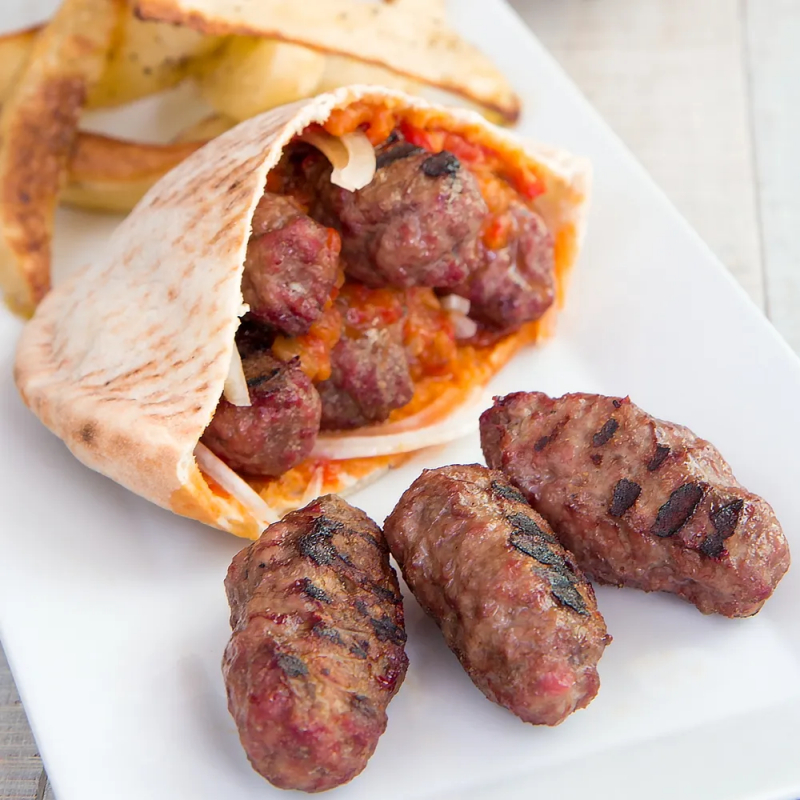
i0.wp.com 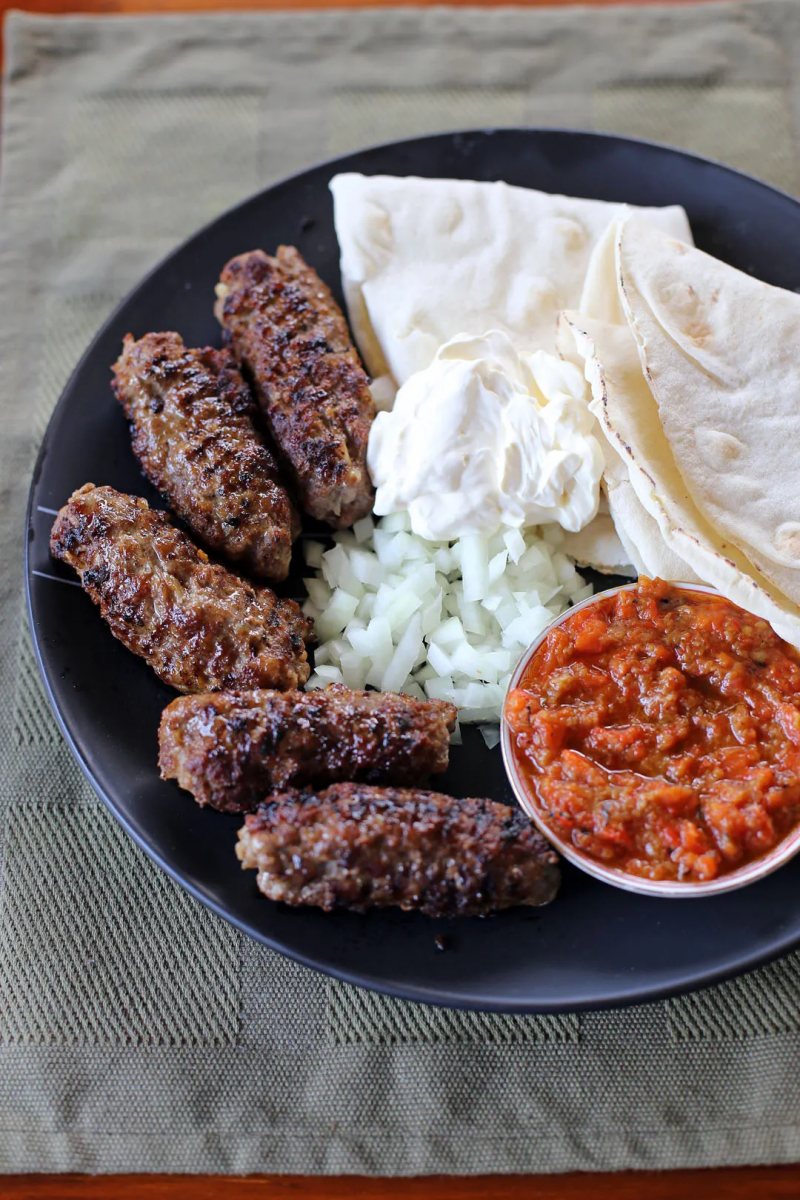
i0.wp.com -
There's no better way to kick off this Bosnian culinary guide than with bosanki lonac, Bosnia and Herzegovina's national dish. It's also known as "Bosnian pot," and it's a traditional vegetable stew that's been served in Bosnia and Herzegovina for generations. The ingredients of this popular Bosnian cuisine vary significantly from cook to cook and region to region, but it usually includes a mix of veggies and meat chunks. Bell peppers, potatoes, cabbage, carrots, tomatoes, garlic, and parsley are some of the most regularly utilized veggies. Meats other than beef, lamb, and veal can be used, however the most popular are beef, lamb, and veal.
Bosnian pot is a dish that is liked by people from all walks of life in the country. Wealthy Bosnians eat it with extra meat and other expensive components, whilst less affluent Bosnians cook it with whatever they have on hand. It was traditionally cooked in clay pots over an open fire or buried in a pit underground, but nowadays it's more typical to cook it in a stovetop pot.
Ingredients
- 2-3 teaspoon oil, 1 yellow onion diced, 2-3 garlic cloves whole peeled and pressed, 2 pounds beef stew chunks diced, 3 carrots large, diced, ½ pound green beans cut into 1 inch pieces, 3 yellow potatoes large, diced, 3 to matoes large, skinned and diced, or 8oz can, 1 teaspoon sugar, 1 teaspoon salt, 1 teaspoon pepper
Instructions
- Put the oil in a large pot over medium-high heat. When it’s hot, add the onion, garlic, and beef stirring occasionally for about 15 minutes. You can add a little water here and there to keep it simmering.
- Lower the temperature to medium, add carrots and continue simmering. Every few minutes add another ingredient: green beans, then potatoes, then tomatoes and sugar, all while adding a little bit of water in between.
- By this time the meat has been simmering for about 30 minutes, and vegetables a little less. Add 3-4 cups of water (so it covers the ingredients, plus a little more). Add salt and pepper. Mix. Cover with lid, leaving a little bit uncovered. Lower the temperature to low, and leave to cook for 90 minutes.
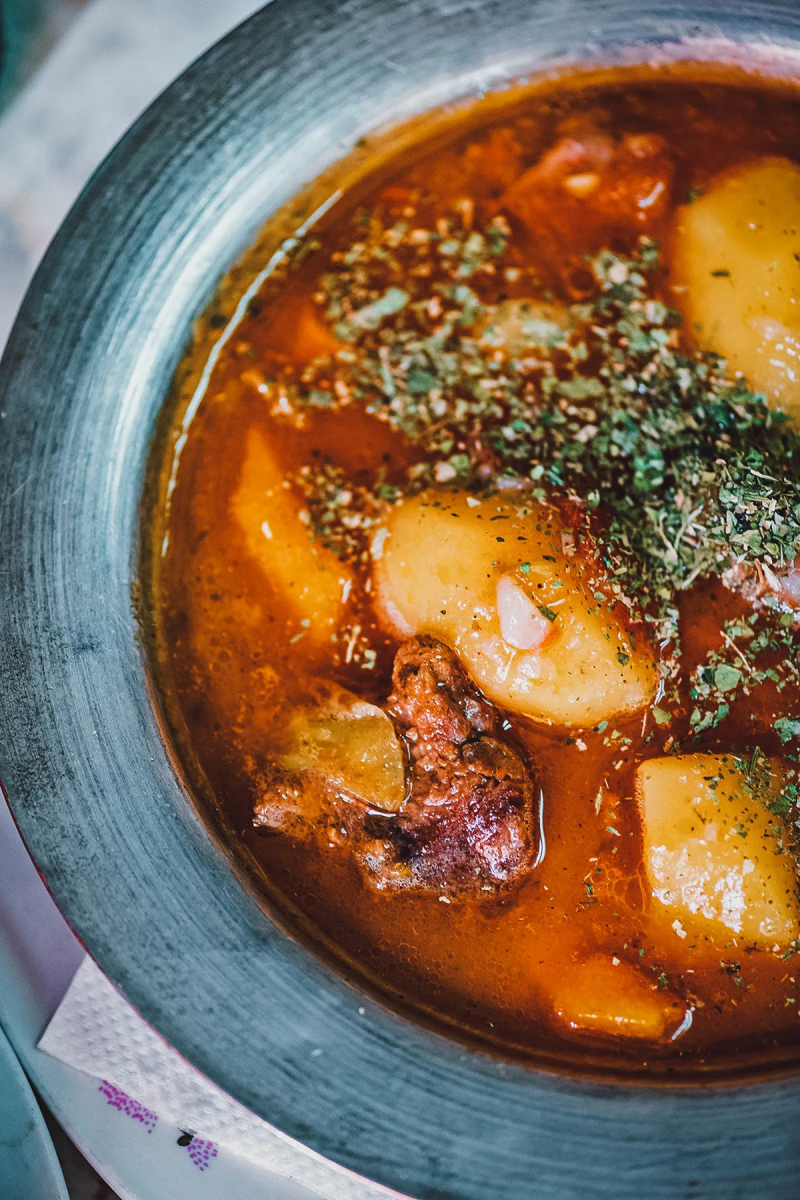
willflyforfood.net 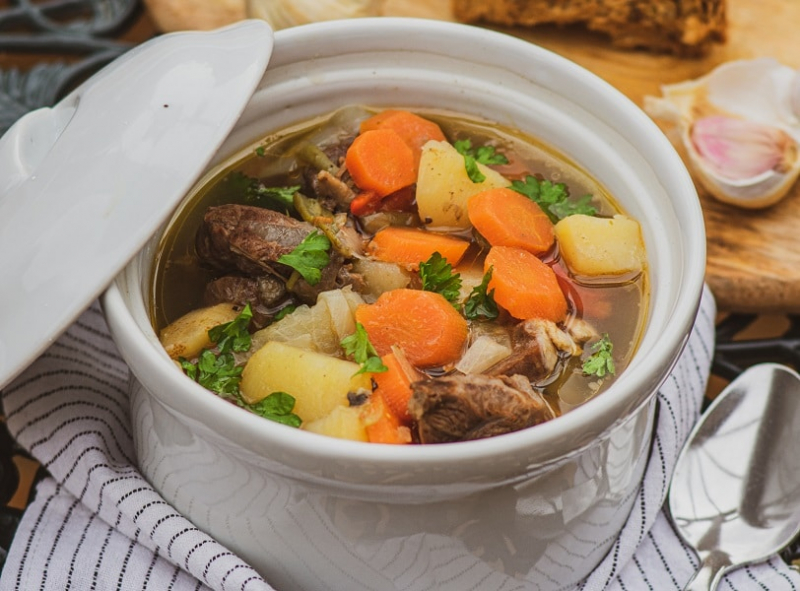
worldfoodstory.co.uk -
Buranija (or boranija) refers to the Bosnian stew as well as the key component - Romano beans. Romano beans are a green bean cultivar similar to snap beans. Buranija is a lighter version of goulash or paprikash. It's typically made with veal slices, but it can also be made with just veggies including carrots, potatoes, onions, and garlic. The ingredients are seasoned with paprika, bay leaves, salt, and pepper before being cooked for hours until the meat is quite soft.
Ingredients
- 1 largeronion head, 3 cherriesgarlic, 1carrots, 1red fresh pepper, 1fresh tomatoes, 500 gr.buranije, spices, vegeta, salt, primrose leaf, 2 tbspflour, half childrenoils, 1 tbspsugar
Instructions
- Put all the ingredients except the burani with half the children's oil to simmer, when it softens a bit, add enough water to cover the ingredients, after 10 minutes add the cleaned and pour the chopped burani with water, cover and cook until almost done.
- In half the children's water, stir in 2 tablespoons of flour and when the buranija is cooked, add it to it and put it in the oven to bake a little.
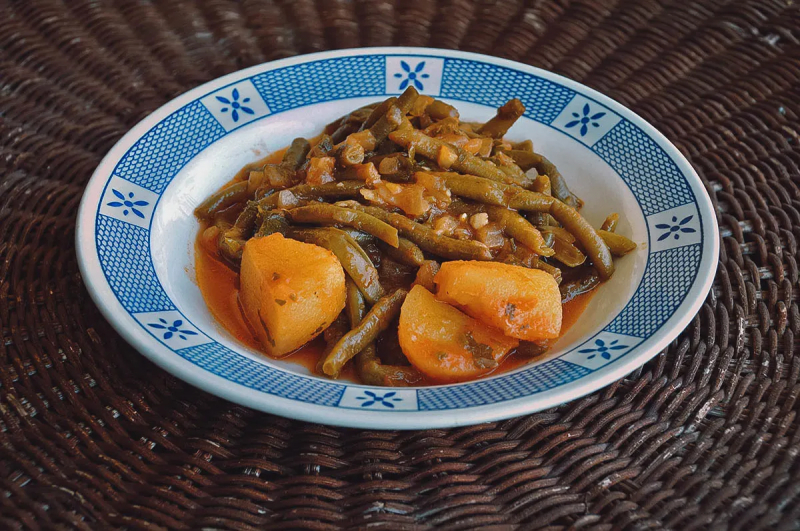
willflyforfood.net 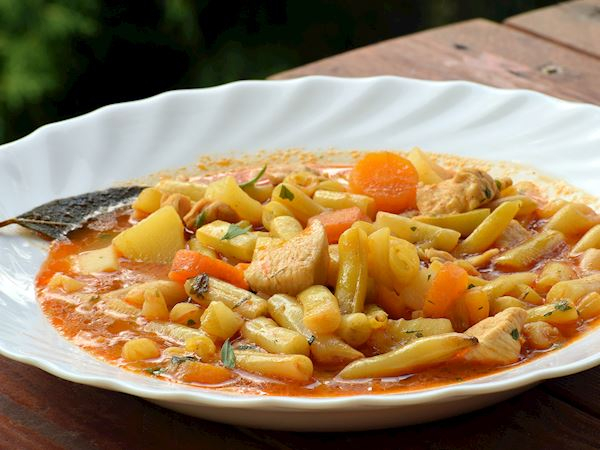
tasteatlas.com -
Prebranac is a traditional Bosnian dish that has also gained popularity in Serbian and Macedonian cuisines. White beans and caramelized onions are seasoned with paprika, garlic, and bay leaves in this casserole. Pebranac is a satisfying and inexpensive dish that was created by farmers to help them get through the harsh winters. Recipes differ from one family to the next because this is a dish that has been passed down through the years. It's a traditional Balkan comfort food served at room temperature with warm crusty bread.
Ingredients
- 600 g butter beans, 600 g onion peeled roughly chopped, 2 table spoons paprika, 2 pcs garlic cloves finely chopped, 4 pcs Bay leaves, 4 table spoons Olive oil, 1 tablesppon Salt, a pinch Black pepper
Instructions
- Pick over beans and rinse. Place beans in 4 quarts water. When it comes to a boil, skim off any foam that rises to the top. Add salt to taste, 1/4 cup oil and 1 teaspoon dried dill or 1 tablespoon fresh dill. Simmer until beans are tender. Drain, rinse in cold water to stop the cooking process and set aside.
- Heat oven to 350 F. In a large Dutch oven or lidded casserole dish or roaster, heat 3/4 cup oil and sauté onions until translucent. Add garlic and sauté until onions are tender. Add tomato sauce, paprika, salt, and pepper to taste, dill to taste and water. Mix in the beans, cover and bake 45 minutes, adding more water, if necessary.
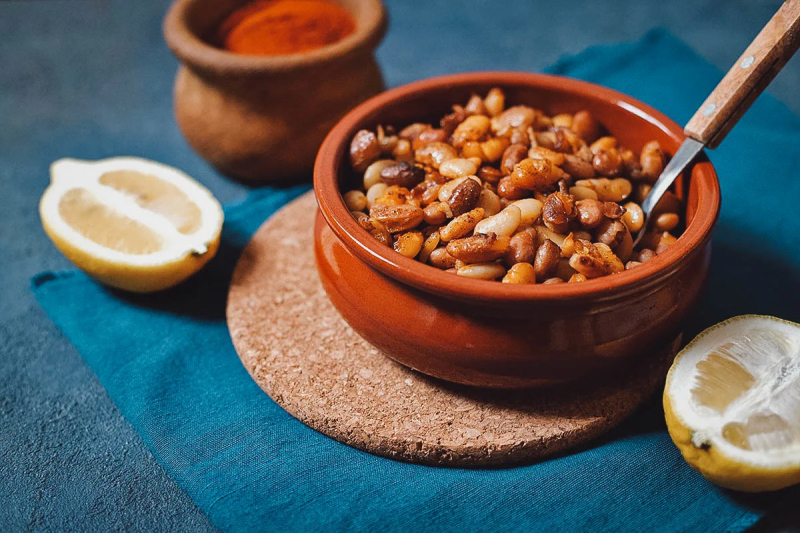
willflyforfood.net 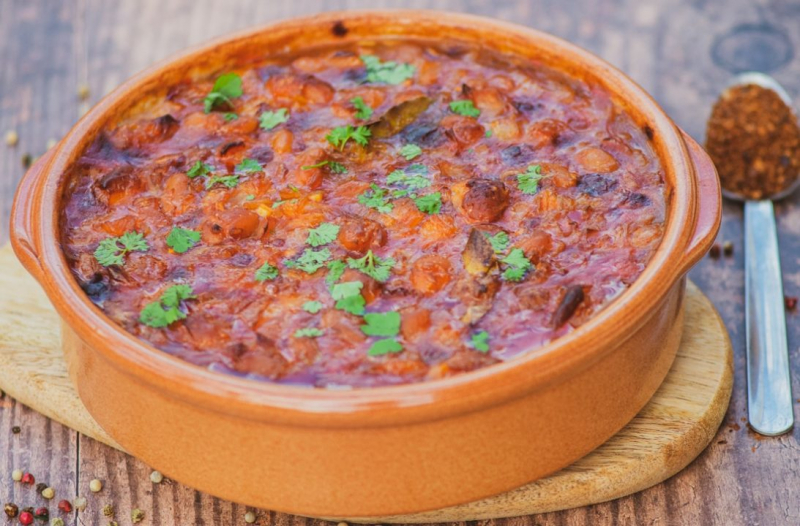
worldfoodstory.co.uk -
Lepinja (or lepinje, somun) is a flatbread that is popular in Bosnia and Herzegovina, Serbia, and Croatian cuisines. It's a frequent type of bread given with cevapi, therefore the term "lepinje za cevapi," which translates to "flatbread for cevapi." Lepinja is a soft and light pita bread with a texture similar to focaccia. It contains milk, which contributes to its soft texture and gentle creamy flavor.
Ingredients
- 500 g (4 cups) all-purpose flour, 360 ml (1 1/2 cup) water, 10 g (1 1/2 tsp) active dry yeast or 20g fresh yeast, 10 g (1 1/2 tsp) salt, 30 g (2 tbsp) lard or canola oil, 2 tbsp semolina or flour, for dusting
Instructions
- Add flour to a large bowl. Create a well in the center of the flour. Add the lukewarm water and yeast. Set aside for 5 - 10 minutes for the yeast to activate. Knead to combine, then add the salt. Knead the dough for 5 minutes by hand or in a stand mixer fitted with a dough hook. Add the lard or canola oil and continue to knead for about 3 - 4 minutes or until smooth. Cover the bowl with a kitchen towel or clingfilm. Set aside to proof for 45 - 60 minutes or until doubled in size.
- Dust your working surface with flour or semolina. Place the Lepinja dough on the floured surface. Shape into a log and cut into six equal parts. Shape each piece into a smooth, round ball. Place back on the floured surface. Cover with a kitchen towel or clingfilm and set aside to proof for 10 minutes.
- Shape each ball into a round flatbread approximately 15 cm or 6-inches in diameter. Place each Lepinja bread on a floured baking sheet. Leave to rest for another 10 - 15 minutes. Then, using a back (dull) side of the knife, make a mesh pattern. Preheat the oven to 250 °C / 480 °F.
- Place the baking sheet (don't line with parchment paper) with the Lepinja bread into a preheated oven on the middle rack. Bake for 8 - 10 minutes at 250 °C / 480 °F or until the flatbread is golden-brown and baked. Transfer to a wire rack, gently splash with water and cover with a kitchen towel. Serve warm or at room temperature.
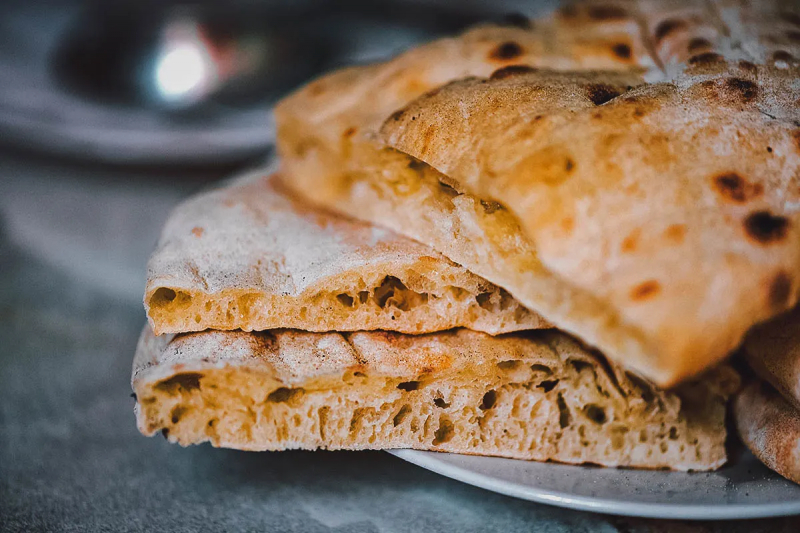
willflyforfood.net 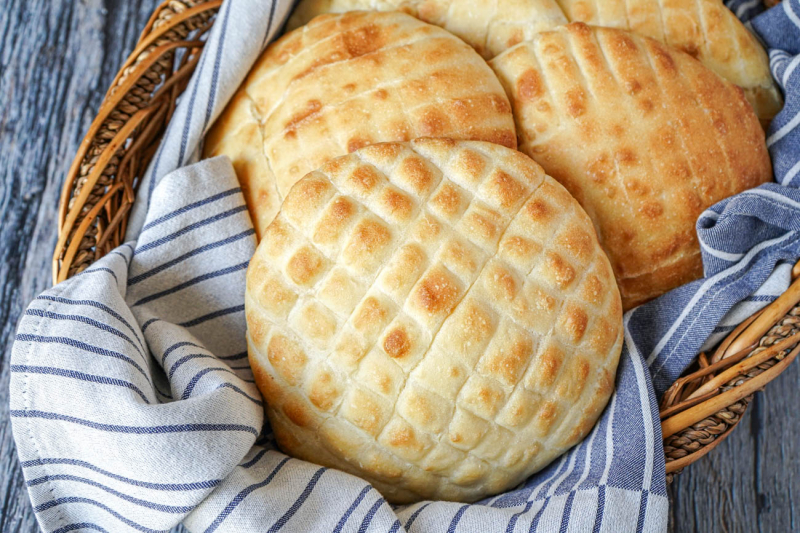
tarasmulticulturaltable.com - 500 g (4 cups) all-purpose flour, 360 ml (1 1/2 cup) water, 10 g (1 1/2 tsp) active dry yeast or 20g fresh yeast, 10 g (1 1/2 tsp) salt, 30 g (2 tbsp) lard or canola oil, 2 tbsp semolina or flour, for dusting
-
Burek is a type of baked filled pastry made from a thin flaky dough stuffed with various contents like as meat, spinach, potatoes, or cheese. It's a common ingredient in the cuisines of the Balkans, the South Caucasus, Central Asia, and the Levant, where it's known as börek or bourekas. Burek comes in a variety of shapes and sizes. It can be baked in a large pan and then divided into smaller pieces, or it can be made as individual pastries. The meal's actual origins are unknown, however it is thought to be a Turkish delicacy that originated in the Ottoman Empire's kitchens.
Ingredients
- Burek Dough: 500 all-purpose flour (3.5 cups), 1 teaspoon of salt, 300-350mls lukewarm water (1 1/4 - 1 1/2 cups), Vegetable oil
- Burek Cheese Filling:, 150 g cottage cheese (2/3 cup), 100 g crumbled feta cheese (2/3 cup), 1 large beaten egg
- Meat And Potato Filling: 1 tablespoon of olive oil, 1 medium, diced onion, 300 g lean beef mince (10 oz), 1 potato, boiled cut into small cubes, 2 grated garlic cloves, Half teaspoon chopped rosemary, fresh is best, Half tablespoon smoked paprika, Half tablespoon salt
Instructions
- How To Make Burek Dough:
- Take a large bowl and combine the flour and the salt
- Add the water bit by bit, mixing until the mixture forms a dough
- Knead the dough for around five minutes, until it turns quite stretchy
- Split the dough mixture into batches of four and press down to flatten
- You need to find a bowl or a pan which is large enough to hold the dough when it is piled up on top of each other
- Add a little bit of vegetable oil to the pan or bowl and put the first flattened piece of dough inside
- Add a bit more oil (not too much), and add another piece of dough – repeat until you’ve done the same with all four pieces
- Add more vegetable oil on top of the last piece and place to one side to rest
- Preheat your oven to around 200°C (390°F)
- Add a little vegetable oil over your work surface (a table is best) – just a little!
- Remove one piece of dough from the bowl and remove the excess oil
- Flatten the piece of dough until it reaches a thickness of no more than around half a centimeter
- Handle the dough and stretch it outwards, over and over, so that you pull it to around 1 meter in diameter – you might end up with a few holes but don’t worry about it too much. By the end, you should be able to see through the dough
- Take one side of the dough disc and fold it over, towards the center
- Repeat this process until you have a shape that resembles a pentagon
- Repeat with the second piece of dough
- Add your filling (see below for the filling instructions) to the dough piece
- Add the first piece of stretched dough into the middle of the second one, and cut away the thick edge of the second piece – you can throw this away, you won’t need it
- Fold over the edges of the dough, so that you get a pentagon shape once more, and put it into a baking pan or tray
- Put the pan in the oven and bake for around half an hour, until it is a golden color
- Remove from the oven and let it cool down
- Cut into 12 pieces
- Repeat the process with the rest of the dough
- Bake until the pastry turns golden, and serve while warm!
- For The Cheese Filling:
- Take a mixing bowl and add in both kinds of cheese, combining together
- Add the egg and combine once more
- For The Meat & Potato Filling:
- Take a large pan and heat up the oil over a medium heat
- Add the onion and cook until soft
- Now, add the mince and cook for around 2 minutes, stirring regularly
- Now, add the potato, the rosemary, the garlic, and the paprika, and stir to combine
- Add the salt and continue to cook, ensuring the beef mince is cooked through
- Once cooked, drain the beef with a sieve to get rid of any excess oil and press down to dry it out
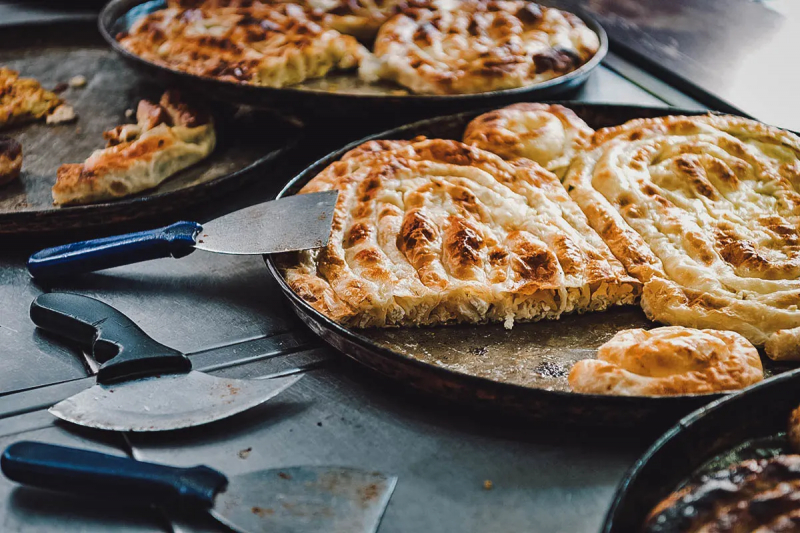
willflyforfood.net 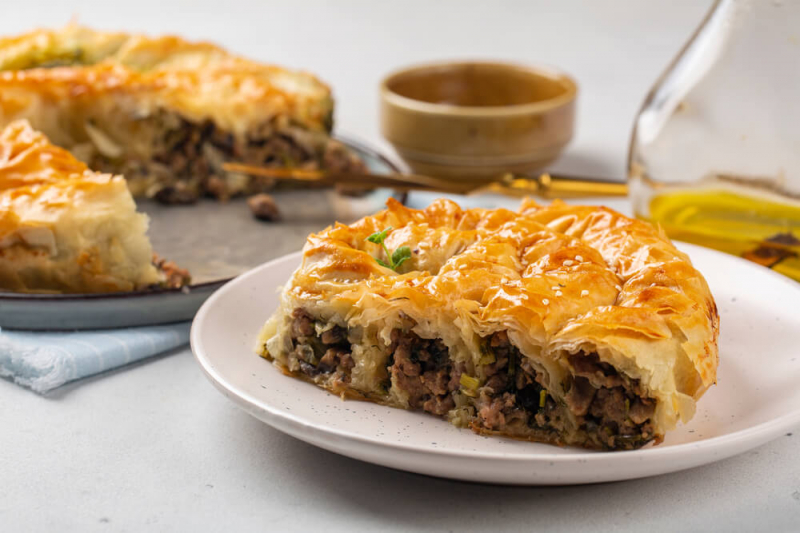
rakijalounge.com -
Dolma refers to a group of stuffed vegetable meals popular in Armenia, Georgia, Lebanon, and a number of other Balkan, South Caucasus, Central Asian, and Middle Eastern countries. It was originally part of Ottoman palace cuisine and means "stuffed" or "full" in Turkish. Dolma is produced by hollowing out a vegetable and stuffing it with a seasoned filling of rice, pork, and other components. Bell peppers, tomatoes, zucchini, onions, and eggplant are just a few examples of vegetables that can be filled and turned into dolma. Punjene paprike is one of the most prevalent forms of dolma (pictured below). Roasted sweet peppers are packed with a rice, ground beef, garlic, onion, paprika, and black pepper mixture.
Ingredients
- 1 (16-ounce) jar grape leaves, 2 tablespoons olive oil, plus more for drizzling, 1 medium yellow onion, finely diced, 4 cloves garlic, finely minced, 1 tablespoon parsley, 1 tablespoon basil, 1 1/2 cups uncookedwhite rice, long-grain, such as basmati, 1/2 cup pine nuts, raw, optional, 8 cups vegetable broth, divided, 2/3 cups lemon juice, divided, plus more for drizzling
Instructions
- Gather the ingredients.
- Gently remove the grape leaves from their jar, then rinse each thoroughly under cold water, taking care not to rip the leaves. Pat the leaves dry and place on a cutting board.
- Using a small, sharp paring knife, remove the stems from the leaves.
- Cover with a paper towel and set aside.
- In a large saucepan over medium-high heat, heat the olive oil, adding the onion, garlic, parsley, and basil once the oil is hot. Stir continuously until the onion is soft and fragrant, about 6 minutes.
- Add the rice and pine nuts and sauté, stirring often, for 3 to 4 minutes longer.
- Add 4 cups of the vegetable broth and bring to a low boil. Turn down the heat to low and simmer for 10 to 15 minutes, or until the rice is cooked, adding water if necessary.
- Add 1/3 cup of lemon juice, stirring well to combine, and cook for 2 to 3 minutes longer or until most of the liquid has been absorbed. Remove the pan from heat.
- Assemble the Dolmas
- Prepare a dry, clean workspace. Place one of the grape leaves, shiny side down, flat on your work surface. Place 1 to 2 tablespoon of filling on the lower-middle portion of the leaf, right above where the stem used to be.
- Fold in the sides of the leaves over the center.
- Then roll the bottom of the leaf over the filling and continue to roll, holding the sides in, until you've rolled the dolma completely and no filling is visible.
- Place the dolma seam-side down in a large saucepan or pot big enough to fit all of the dolmas in a single layer.
- Repeat until all of the grape leaves are used, placing one dolma directly next to the other and leaving no space in between.
- Drizzle another 1 to 2 tablespoons of olive oil over the dolmas, followed by the remaining lemon juice.
- Pour the remaining 4 cups vegetable broth over the grape leaves to cover.
- Cover the pot and simmer over medium-low heat for 1 hour (do not boil). Add water as necessary to keep them covered.
- Remove the pan from heat, uncover, and let the dolmas cool in the liquid for 20 to 30 minutes.
- Using a slotted spoon, gently transfer the dolmas to a serving dish. Drizzle with olive oil and lemon juice and serve at room temperature or cold.
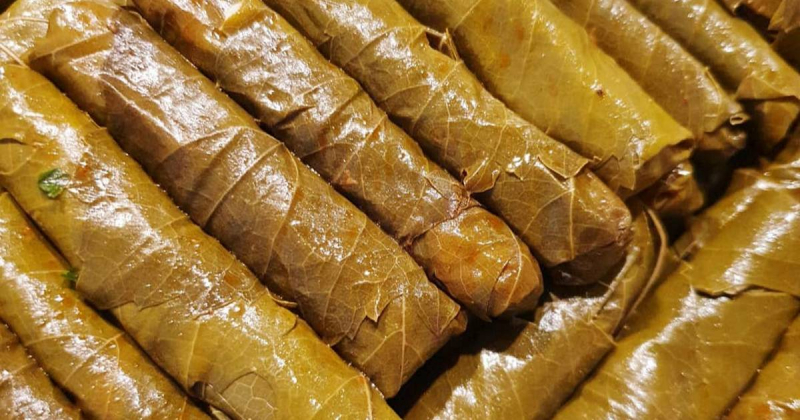
thespruceeats.com 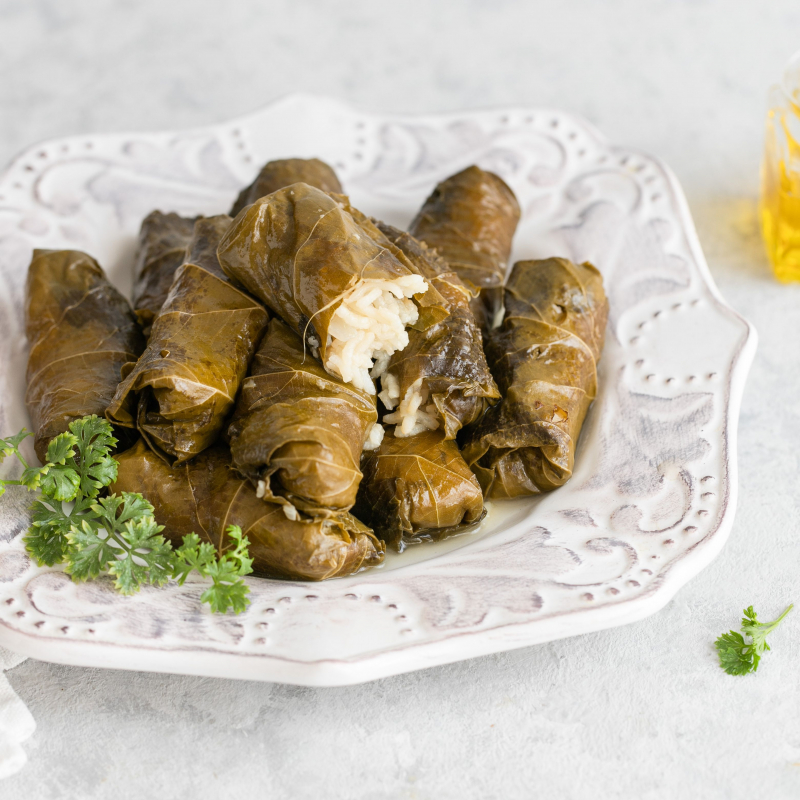
thespruceeats.com









